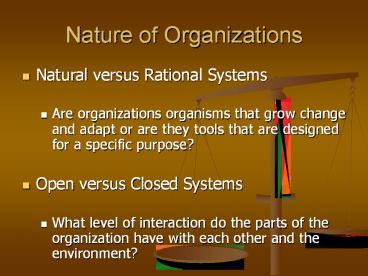Nature of Organizations - PowerPoint PPT Presentation
Title:
Nature of Organizations
Description:
Nature of Organizations Natural versus Rational Systems Are organizations organisms that grow change and adapt or are they tools that are designed for a specific purpose? – PowerPoint PPT presentation
Number of Views:106
Avg rating:3.0/5.0
Title: Nature of Organizations
1
Nature of Organizations
- Natural versus Rational Systems
- Are organizations organisms that grow change and
adapt or are they tools that are designed for a
specific purpose? - Open versus Closed Systems
- What level of interaction do the parts of the
organization have with each other and the
environment?
2
Rational Systems
- Organizations as tools that are controlled as
purposeful and coordinated agents for the
principal - Rational calculation
- Goal Specificity
- Formalized planning
- Translation of plans into specific objectives
- Formalization of structure
- Explicit and visible
- Division of labor
3
Natural Systems
- Organizations as natural organisms that exist
within an environment - Goal complexity
- Informal structure
- Irrationality leads to informal norms and
behaviors - Functional analysis of organizations
- Population ecology
4
Closed Systems
- One or few points of contact with the environment
- No change of system
- No intake of energy, material, or information
5
Open Systems
- Connection of many parts that make up the
organization - Multiple or many points of interaction with the
environment - Self-maintenance
- Goal directed
- Reciprocal ties that bind and relate the
organization to the environment - Environment is ultimate source for materials
energy and information
6
Examples
Prisons Boarding schools Military schools
Schools Franchises Police Departments
Social clubs Universities Corporations Governments
Hmmmmm?
7
Options of Organizational Design
Complex, Dynamic
Network Design
Multinational Design
Matrix Design
Environmental Forces
Product Design
Place Design
Functional Design
Simple, Stable
Simple
Complex
Technological Forces
8
Division of Labor and Coordination
- Division of labor
- Subdivision of work into separate jobs assigned
to different people - Coordination of work activities
- informal communication
- formal hierarchy
- standardization
9
Span of Control
- Number of people directly reporting to the next
level - Assumes coordination through direct supervision
- Wider span of control possible when
- other coordinating mechanisms exist
- people do similar tasks
- tasks are routine
- Flatter structures require narrow span (if same
of people)
10
Mechanistic vs. Organic Structures
11
Variables That Differentiate BetweenMechanistic
and Organic Systems
- Hierarchy of authority
- Centralization
- Division of labor
- Rules
- Procedures
- Impersonality
- Chain of command
- Unity of command
- Span of control
12
Callaway Golfs Design by Function and Process
President
New Products
Manufac- turing
Planning
Finance
Functions
Quality Control
Forging
Assembly
Shipping
Processes
Source Adapted from Callaway Golf 1996 Annual
Report. Carlsbad, Calif., 1997.
13
Practical Implications of a Functional Design
- Specialized staff departments enable firm to deal
more effectively with environmental complexity
and dynamism. - Most employees may lose sight of need to meet or
exceed customer expectations.
- Clear identification of responsibilities.
- May be effective when company has a narrow
product line, competes in a uniform environment,
pursues a low-cost or focused business strategy,
and does not serve different regions and
customers.
14
Practical Implications of a Place Design
- Promotes direct contact among different
organizational units and stakeholders demands. - Lower costs.
- Marketing tactics can be tailored to regions.
- Control and coordination problems increase.
- Employees may overemphasize own units goals and
needs.
15
United Technologies
CEO
Otis Elevators Escalators Moving walks
UT Auto- motive Automotive electrical
systems Electric motors Automotive
interior exterior trim
Flight Systems Helicopters Propellers Space
life support systems
Carrier Heating air conditioning
Building controls Refriger- ation
equipment
Pratt Whitney Jet engines Rocket
engines Industrial gas turbines
Source http//www.utc.com/Annual98/glance.htm.
16
Practical Implications of a Product Design
- Reduces information overload
- The addition of product lines, diverse customers,
and technological advances increases the
complexity and uncertainty. - Incorporates features of functional design.
- Eases problems of integration by focusing
functional expertise and knowledge on specific
goods or services. - Higher costs result from duplication of various
functions.
17
Practical Implications of a Multidivisional Design
- Eases problems of integration by focusing
functional expertise and knowledge on specific
goods or services. - Higher costs result from duplication of various
functions.
18
Partial Illustration of Basic Matrix Design
President and Chief Executive Officer
Quality Control Engineer for Product Line A
Manager, Personnel
Manager, Product Line A
Quality Control Engineer for Product Line B
Manager, Product Line B
Manager, Production
Manager, Finance and Accounting
Quality Control Engineer for Product Line C
Manager, Product Line C
These product managers also have full
responsibility for the marketing activities
associated with their own product lines.
19
Practical Implications of a Matrix Design
- Enables employees to be highly responsive to dual
concerns. - Enables firm to deal with uncertain environment
and technologies. - Enables firm to deal effectively with multiple
products and limited resources. - Makes specialized knowledge available to all
projects.
- Uses people flexibly.
- Demands substantial managerial resources while
employees learn to operate in the new
organization. - Learning may be a lengthy process because of
required attitude changes. - Special training programs may be needed.
20
Implications of a Multinational Design
- Worldwide product-line divisions will be more
dominant than geographically based divisions
under certain conditions. - A worldwide product-line division may not be as
effective at opening up new territories as a
geographically organized division. - A division operating under a place design often
can establish relations with host governments,
invest in distribution channels, develop brand
recognition, and build competencies that no
single product-line division could afford.
21
Key Elements of a Network Design
- Distinctive competence
- Responsibility
- Goal setting
- Communication
- Information technology
- Organizational culture
- Balanced view
22
Network Organizational Structure
MarketingFirm(U.K.)
ProductDevelopmentFirm(France)
CoreFirm(U.S.A.)
CustomerServiceFirm(U.S.A.)
ProductionFirm(China)
AccountingFirm(U.S.A.)































